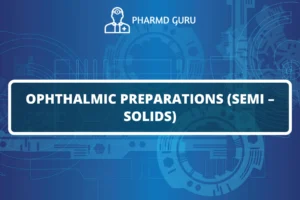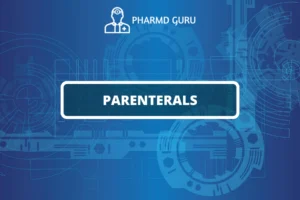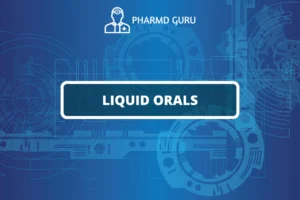Capsules are widely used pharmaceutical dosage forms that provide an alternative to tablets for oral drug delivery. They offer benefits such as easy swallowing, dose flexibility, and the ability to mask taste. In this article, we will explore the production and filling processes for both hard gelatin capsules and soft gelatin capsules, as well as the quality control tests associated with each type.
SCROLL DOWN TO THE BOTTOM OF THIS PAGE FOR ACTUAL NOTES.
Table of Contents
- Introduction
- Hard Gelatin Capsules
- 2.1 Production of Hard Gelatin Capsules
- 2.2 Filling of Hard Gelatin Capsules
- 2.3 Raw Material for Hard Gelatin Capsule Shells
- 2.4 Finishing of Hard Gelatin Capsules
- 2.5 Quality Control Tests for Hard Gelatin Capsules
- Soft Gelatin Capsules
- 3.1 Production and Filling of Soft Gelatin Capsules
- 3.2 Quality Control Tests for Soft Gelatin Capsules
1. Introduction
Capsules are solid dosage forms that consist of an outer shell and contain the active pharmaceutical ingredient (API) and other excipients. They come in two main types: hard gelatin capsules and soft gelatin capsules. The production, filling, and quality control processes differ for each type.
2. Hard Gelatin Capsules
2.1 Production of Hard Gelatin Capsules
The production of hard gelatin capsules involves several steps:
- Gelatin Preparation: Gelatin, derived from animal sources, is first processed and purified to obtain the necessary characteristics for capsule production.
- Shell Formation: The gelatin is melted, and the solution is fed into the capsule-forming machine. The machine molds the gelatin into two halves: the body and the cap of the capsule.
- Drying and Stripping: The formed capsules are dried to remove excess moisture. They are then stripped from the molds and trimmed to the desired length.
2.2 Filling of Hard Gelatin Capsules
The filling of hard gelatin capsules is typically performed using automatic capsule-filling machines. The process involves the following steps:
- Preparing the API: The active ingredient is prepared in the desired form, such as powder or granules.
- Capsule Orientation: The machine orients the empty capsules with the open end facing upward.
- Powder Filling: The API or a blend of API and other excipients is dispensed into the lower capsule body. Excess powder is scraped off to ensure accurate dosing.
- Cap Placement: The machine places the upper capsule cap onto the filled body, joining the two halves to form a complete capsule.
- Capsule Ejection: The filled and sealed capsules are ejected from the machine and collected for further processing.
2.3 Raw Material for Hard Gelatin Capsule Shells
The raw material for hard gelatin capsule shells is gelatin, which is obtained from collagen found in animal tissues. Gelatin undergoes purification and processing to meet the necessary quality and safety standards for pharmaceutical use.
2.4 Finishing of Hard Gelatin Capsules
After filling, hard gelatin capsules may undergo additional processing steps to enhance their appearance and functionality. These steps may include printing, polishing, banding, and sorting to ensure uniformity and facilitate identification.
2.5 Quality Control Tests for Hard Gelatin Capsules
Hard gelatin capsules undergo various quality control tests to ensure their integrity and performance. Some common quality control tests for hard gelatin capsules include:
- Capsule Weight Variation: Capsules are checked for weight uniformity to ensure consistent dosing.
- Disintegration Test: The disintegration test assesses the time it takes for the capsule shell to disintegrate and release the contents.
- Dimensional Checks: Capsules are measured for their dimensions, including length and diameter, to ensure compliance with specifications.
- Visual Inspection: Capsules are visually inspected for defects such as cracks, chips, and discoloration.
- Moisture Content: The moisture content of the capsule shells is measured to ensure stability and prevent microbial growth.
3. Soft Gelatin Capsules
3.1 Production and Filling of Soft Gelatin Capsules
The production and filling of soft gelatin capsules involve a different set of processes compared to hard gelatin capsules:
- Gel Mass Preparation: Gelatin and other ingredients, such as plasticizers and preservatives, are mixed and heated to form a gel mass.
- Shell Formation: The gel mass is encapsulated in a machine that forms the soft gelatin capsule shells.
- Filling: The liquid or semi-solid fill material, containing the API and other excipients, is injected into the formed soft gelatin capsules.
- Seal Formation: The two halves of the soft gelatin capsules are sealed together, enclosing the fill material.
3.2 Quality Control Tests for Soft Gelatin Capsules
Soft gelatin capsules undergo quality control tests to ensure their quality, safety, and performance. Some common quality control tests for soft gelatin capsules include:
- Shell Integrity: Capsules are inspected for any leakage or damage to ensure the integrity of the shell.
- Content Uniformity: Content uniformity testing ensures that the amount of API in each soft gelatin capsule is within the specified range.
- Dissolution Test: The dissolution test evaluates the release rate of the API from the soft gelatin capsule using appropriate dissolution apparatus and media.
- Microbiological Testing: Soft gelatin capsules undergo microbial testing to ensure they meet the required standards for microbial limits.
ACTUAL NOTES:




